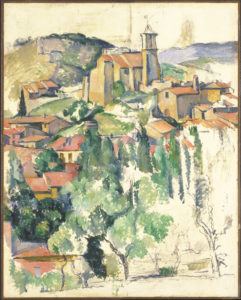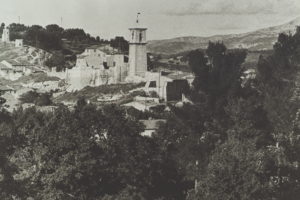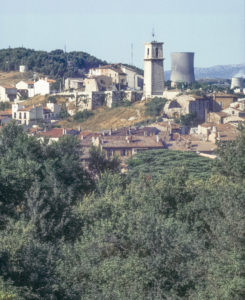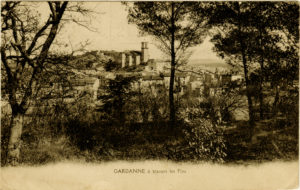R571 – Gardanne (l’après-midi), vers 1886 (FWN223)
Pavel Machotka
(Cliquer sur l’image pour l’agrandir)
Gardanne (l’après-midi), too, achieves a stately presence, both from the remarkable simplicity of its site and the discreet emphases – and omissions – of Cézanne’s treatment. If one takes into account the buildings that have disappeared (which were missing already in the 1930s, at the time of Mr. Rewald’s photograph of the motif), and the few that have been added, it is clear that the composition of the painting is given by the disposition of the objects in the motif. No specific transformations are suggested. Yet Cézanne creates a movement in the picture that is not visible in the photograph: by painting the roofs in the middle left somewhat redder, and the group of trees beneath them darker, he creates a broad S-curve which starts at bottom center, sweeps toward the left middle and then, still ascending, curves back rightwards toward the church; its apex is the bell-tower. The gentle slopes of the Provençal roofs now move across the canvas. Indeed, that progression may best explain why the trees on the bottom have been left unfinished: standing alone, they echo the larger movement. Filling in the spaces between their trunks would have obscured their shape and, given the additional weight, would have anchored our gaze in the corner.
One cannot but notice that the shadow crossing the bell-tower is parallel to the slope of the roofs; it participates in the rhythm of the whole. The cornice which casts it is narrow and the shadow crosses the wall for only a brief time. It tempts one to wonder whether Cézanne, like Monet, did not paint on the site for a brief period of time each day in order to represent a specific moment. But that is not likely: while Cézanne’s shadows have a clear location, his light has little of Monet’s precise and fine particularity. In any case, Bernard’s observations say clearly enough that in his last years Cézanne seemed to go to the motif for the whole afternoon and work on one painting only. If that was also his practice in the mid-eighties, it seems improbable that he would have sought to capture precise moments.
Advancing shadows pose an inescapable problem for all plein air painters, and there is only a limited number of ways they can respond to them. Painters who see a promise in their very first view of a site will fix on the shadows they saw and remain with them, while others, perhaps more flexible or impulsive, may change their painting’s composition as the shadows move. Some may aspire to grasp only a moment in time, but then they must not only freeze the shadows but, like Monet, also record the first moment’s particular light, and resist the temptation to respond to the inexorable changes by putting the painting down after a short while and starting another. There is no suggestion either in this painting or in Bernard’s observation that Cézanne did so. That the cornice casts this shadow at 4:30 in the summer was probably a happy discovery at an early point in the afternoon’s work, and Cézanne felt no reason to give it up.
Source: Pavel Machotka: Cézanne: Landscape into Art
NB. Carte postale ancienne avec une vue prise vers 1900 depuis la colline des Frères (de plus haut que le point de vue de Cezanne) :





